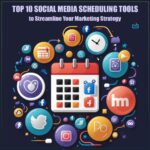Primary Data Vs Secondary Data in Marketing Research
In the dynamic landscape of marketing, the significance of well-informed decisions cannot be overstated. At the core of this process lies the invaluable resource of data. The bedrock of robust marketing research is built upon the foundation of data, which can be conveniently categorized into two distinct yet complementary types: primary data and secondary data. Throughout this article, we will dive into the nuances, advantages, and versatile applications of both primary and secondary data in marketing research.
In today’s fast-paced marketing environment, staying ahead necessitates a comprehensive understanding of data-driven strategies. This involves harnessing the power of both primary and secondary data sources. Let’s embark on a journey to unravel the depths of their contributions and unlock their potential for marketing success.
Related Articles
1) Primary Data: The Fresh Insights
Primary data, also referred to as firsthand or raw data, constitutes information obtained directly from the source for a designated research objective. This form of data is inherently original, with researchers employing techniques such as surveys, interviews, focus groups, observations, and experiments to gather it. Let’s delve deeper into the facets of primary data:
a) Tailored Insights
One of the most significant advantages of primary data lies in its bespoke nature. It is meticulously crafted to address the specific research inquiries at hand, providing a comprehensive exploration of issues pertinent to your business.
b) Timeliness and Pertinence
Given its purpose-driven collection, primary data tends to be exceptionally current and directly aligned with your research objectives. This ensures that the insights gleaned are not only timely but also directly applicable to your specific area of focus.
c) Exerting Authority over Data Collection
A notable benefit of utilizing primary data is the level of control it affords you over the data collection process. This enables you to design and execute methodologies that align precisely with your research goals, ensuring the highest level of accuracy and relevance in the information obtained.
2) Secondary Data: The Treasure Trove of Existing Information
Secondary data, in essence, constitutes information that was originally gathered for a separate objective, frequently by a different entity.
This category encompasses an extensive range of sources, spanning from authoritative government publications and insightful industry reports to scholarly pearls found in academic journals, along with the invaluable archives of established companies.
Let’s delve into a deeper understanding of the multifaceted world of secondary data:
a) Cost-Efficiency
Leveraging secondary data often proves to be a more economically sound option when compared to the process of primary data collection. Many of these sources are readily accessible or can be procured at a relatively lower expense, making it an astute choice for research endeavors with budget considerations.
b) Diverse Perspectives
The beauty of secondary data lies in the diverse array of perspectives it encapsulates. By drawing from a multitude of sources, researchers gain access to a rich tapestry of insights, providing a broader context for their inquiries. This holistic viewpoint can uncover overarching trends and correlations that may not be as readily apparent in narrower, primary-focused approaches.
c) Historical Context
Secondary data, owing to its pre-existing nature, offers a valuable historical backdrop. It allows researchers to trace the evolution of trends, offering invaluable context to contemporary studies. This historical lens can be instrumental in identifying patterns and forecasting future trajectories within a given field of inquiry.
d) Validity and Reliability
Established sources of secondary data, such as reputable government publications and well-regarded industry reports, often come with a built-in level of validity and reliability. This is owing to the rigorous standards and methodologies employed in their original collection. Researchers can therefore have confidence in the credibility of the data they are leveraging.
While secondary data serves as a powerful resource, it’s essential to approach its utilization with a discerning eye. Researchers should critically evaluate the source, methodology, and relevance of the data to ensure it aligns seamlessly with their specific research objectives. With judicious use, secondary data can be a cornerstone in constructing robust and insightful research endeavors.
Also Read: Secondary Data in Research Methodology
3) Applications of Primary and Secondary Data in Marketing Research
a) Primary Data
When you require highly specific information about your target audience or product, primary data steps in as the invaluable tool for precision. By directly engaging with your audience through surveys, interviews, or observations, you gain insights that are uniquely tailored to your research goals. This data forms the bedrock of understanding consumer behavior and preferences, providing a solid foundation for strategic decision-making.
2) Secondary Data
Complementing primary data, secondary data casts a wider net by drawing upon existing sources. This includes market reports, academic studies, and industry publications. This wealth of information offers valuable context, historical trends, and broad market perspectives.
By creating secondary data with primary insights, you create a comprehensive view that informs your marketing strategies with depth and breadth. It serves as a compass for navigating the competitive landscape and identifying opportunities for growth.
FAQs – Frequently Asked Questions & Answers
Q. 1. What is the fundamental difference between primary data and secondary data in marketing research?
Primary data is original information collected directly for a specific research objective, while secondary data is pre-existing data collected for other purposes.
Q. 2. What advantages does primary data offer in marketing research?
Primary data provides tailored insights, timeliness, and allows researchers to have full control over the data collection process.
Q. 3. How does secondary data contribute to cost-efficiency in marketing research?
Secondary data is often more cost-effective than collecting primary data, as it can be readily accessible or procured at a lower expense.
Q. 4. Why is secondary data valued for providing diverse perspectives in marketing research?
Secondary data draws from a multitude of sources, offering a wide range of insights that provide a broader context for research inquiries.
Q. 5. How can secondary data help in understanding historical trends and patterns in marketing research?
Secondary data, due to its pre-existing nature, offers a historical backdrop, allowing researchers to trace the evolution of trends and make future forecasts.
Q. 6. Why is it important to critically evaluate secondary data sources in marketing research?
It’s crucial to assess the source, methodology, and relevance of secondary data to ensure it aligns with specific research objectives and maintains credibility.
Conclusion
In the dynamic field of marketing research, harnessing the power of both primary and secondary data proves to be a strategic imperative. These two invaluable tools, while distinct in their approaches, bring forth a wealth of advantages and considerations. The true prowess lies in the astute integration of these data types.
By skillfully navigating the terrain of primary and secondary data utilization, marketers elevate their decision-making acumen, ultimately securing a formidable competitive advantage in their respective industries. This synergistic approach sets the stage for not only insightful strategies but also sustained success in the ever-evolving market landscape.



